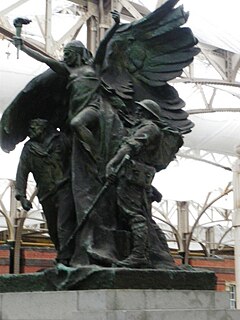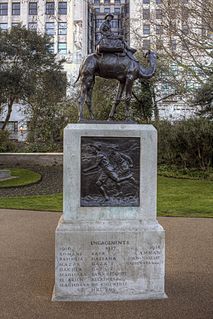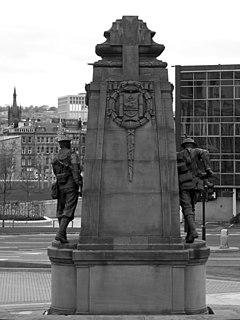
Albert Halton VC was an English recipient of the Victoria Cross, the highest and most prestigious award for gallantry in the face of the enemy that can be awarded to British and Commonwealth forces.

The National War Memorial in Downtown St. John's is the most elaborate of all the post World War I monuments in Newfoundland and Labrador. It was erected at King's Beach on Water Street where, in 1583, Sir Humphrey Gilbert claimed Newfoundland for England. It was formally unveiled on Memorial Day, July 1, 1924 by Field Marshal Douglas Haig, 1st Earl Haig.

Sai Wan War Cemetery is a military cemetery located in Chai Wan, Hong Kong which was built in 1946. The cemetery was created to commemorate soldiers of Hong Kong Garrison who perished during the Second World War. The cemetery also contains 12 World War I burials. A total of 1,528 soldiers, mainly from the Commonwealth, are commemorated here. Most of the remaining burials are located at the Stanley Military Cemetery.

Dover Marine War Memorial stands in the old Dover Marine Station in the Western Docks, Dover, England. The port has effectively been closed for several years; it is currently used as a berthing station for cruise liners, and is only open when a liner is in dock.

The National Submariners' War Memorial is a war memorial on the Victoria Embankment in London, England, between Waterloo Bridge and Blackfriars Bridge. The memorial is also referred to as the National Submarine War Memorial, the National Submarine Memorial, the Submarine War Memorial and the Submariner Memorial. It commemorates the Royal Navy submariners who died in the First and Second World Wars. The Royal Navy Submarine Service had 57 operational vessels at the start of the First World War in 1914, but expanded to 137 vessels by the time the war ended in 1918, with another 78 under construction. During the war, 54 of its submarines were sunk, and over 1,300 Royal Navy submariners were killed. The memorial is a Grade II* listed building, and it is the focal point of a special memorial walk and laying of wreaths held each year by submariners on the Sunday preceding Remembrance Sunday.

Redheugh Gardens War Memorial or Hartlepool War Memorial is a World War I and World War II memorial located in the Headlands of Hartlepool, County Durham, England. It commemorates Hartlepool military servicemen and civilians who lost their lives in both wars – with specific mention of the first British soldiers to have died on British soil during 16 December 1914 Raid on Scarborough, Hartlepool and Whitby of World War I. In 2001 a plaque was unveiled to memorialise 240 men and women who succumbed from 1919 to 1967 during war and conflict.

The Royal Fusiliers War Memorial is a memorial in London, dedicated to the members of the Royal Fusiliers killed in the World Wars, Russian Civil War and subsequent conflicts, along with members of a number of London Regiment battalions killed in the First World War. It consists of a bronze statue on a 16.5 feet (5.0 m) pedestal made of Portland stone.

The Midland Railway War Memorial is a First World War memorial in Derby in the East Midlands of England. It was designed by Sir Edwin Lutyens and unveiled in 1921. The memorial commemorates employees of the Midland Railway who died while serving in the armed forces during the First World War. The Midland was one of the largest railway companies in Britain in the early 20th century, and the largest employer in Derby, where it had its headquarters. Around a third of the company's workforce, some 23,000 men, left to fight, of whom 2,833 were killed.

The Imperial Camel Corps Memorial is an outdoor sculpture commemorating the Imperial Camel Corps, located in Victoria Embankment Gardens, on the Thames Embankment to the east of Charing Cross station, in London, England. The unit of mounted infantry was created in December 1916 from troops that had served in the Gallipoli campaign in the Dardanelles.

The Cavalry of the Empire Memorial, also known as the Cavalry Memorial, is a war memorial in Hyde Park, London. It commemorates the service of cavalry regiments in the First and Second World Wars. It became a Grade II listed building in 1987, and was promoted to Grade II* in November 2014.

The Cameronians War Memorial is a war memorial in Kelvingrove Park in the west of Glasgow, Scotland, to the north of Kelvingrove Art Gallery and Museum. It commemorates the service of the Cameronians regiment in the First and Second World Wars. The memorial includes a bronze sculpture representing a machine gun emplacement, with three human figures. It became a Category B listed building in 1988.

Finchley War Memorial is located in Ballards Lane, North Finchley, outside the United Services Club. It was unveiled by Viscount Lascelles on the 13th November 1925, an event that was attended by thousands of people. The memorial is dedicated to 1,000 servicemen and women from Finchley who died in World War I. After the ceremony, dignitaries addressed a tightly packed gathering in the St Kilda Hall. Finchley sent over five thousand men to the Colours. Finchley United Services Club

Croydon Cenotaph is a war memorial, in Croydon, London, England. It is located outside the Croydon Clocktower arts complex, on Katharine Street in Croydon.

The York and Lancaster Regiment War Memorial is a war memorial to members of the York and Lancaster Regiment, in Weston Park, Sheffield, England. It was erected in the park in 1923 to commemorate the 8,814 members of the regiment who died in the First World War. The original inscription reads:

Blackmoor War Memorial is a First World War memorial cloister in Blackmoor, near Liss, in Hampshire. The memorial stands on the north side of the main road, with the Church of St Matthew to the east and the village school to the west. It was designed by Sir Herbert Baker, and comprises a three-sided wood-framed arcade, open to the south, arranged around lawn with a memorial cross. Several memorial plaques and a fountain by Sir Charles Wheeler are mounted on the walls of the arcade. It is one of around 130 Grade II* listed war memorials in England.

Bradford War Memorial commemorates the 37,000 men the English city of Bradford who served in the British Armed Forces in the First World War. Many of the 5,000 dead had served in the two Bradford Pals battalions and were killed on 1 July 1916, the first day of the First Battle of the Somme. The stone pylon with bronze statues was unveiled on 1 July 1922, in Victoria Square, beside Prince's Way, to the northeast of the Grade II listed Queen Victoria Memorial. A bronze plaque was added after the Second World War, and the memorial also commemorates later conflicts. It stands between the National Media Museum and Alhambra Theatre, Bradford, and was Grade II listed in 2016.

Streatham War Memorial is a war memorial to the war dead of the London district of Streatham in the two World Wars. It was unveiled in 1922, and is sited near the northwest corner of Streatham Common.
Onslow Ernest Whiting was an English sculptor and teacher.

The monument to the King's Liverpool Regiment is a war memorial in St John's Gardens in the city centre of Liverpool, England. The memorial commemorates those members of the King's Regiment (Liverpool) who lost their lives on campaign in the Second Anglo-Afghan War (1878–1880), the Third Anglo-Burmese War (1885–1887) and the Second Boer War (1899–1902). It was funded by a public subscription and with the support of the Corporation of Liverpool. It was unveiled on 4 August 1905 by Field Marshal Sir George White. The monument is a rare example of a large-scale public regimental memorial from the pre-First World War era. Its central figure is that of Britannia with other statues showing soldiers of the regiment in 1685, 1743 and 1902.



















